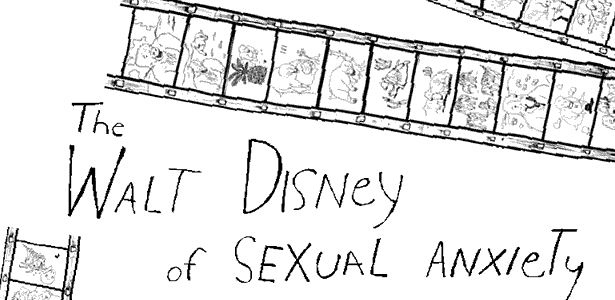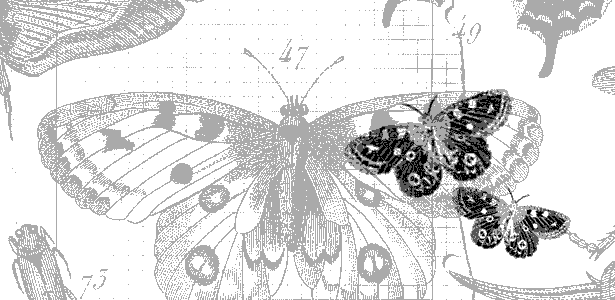
by Russell Gottwaldt
There’s no reason for you to spend any time in Oregon, but if you attended the Portland Documentary and eXperimental Film Festival this year, you might have been able to see Harmony, a new animated short film by SAIC’s own animation instructor and filmmaker, Jim Trainor. If you were luckier still, you might have also read this flattering review from The Portland Mercury following Trainor’s screening:
The word “experimental” can be scary to some, but there’s nothing to fear from experimental shorts—the good ones are perfect little self-contained gems; the bad ones are over before you get a chance to slit your wrists… Jim Trainor’s Harmony, for instance, is bad; an animated montage of hideous, morphing jungle animals and other weird images, backed by a voiceover that features lines like, “We cut a little boy’s penis open. We used a sharp knife. We wanted to give him a little vagina.” This is the kind of pointlessly offensive tripe that gives experimental film a bad name, but then it only lasts 12 minutes.
“I think that he just thought that I made it up just out of some perverse, private instinct of my own,” said Trainor about the genital mutilation scene in Harmony, which prompted the scathing review, “and it was clear to me that this particular reviewer just didn’t quite get it. But I also avow that I deliberately make my movies very hard to get. I mean, Harmony is a string of these ten vignettes that are each kind of horrible, and they each come from a dif-ferent perspective, so it continually throws the viewer off. I just think that smarter viewers realize that I’m not just doing it to be naughty or disgusting, that I’m pursuing an overall idea, but not everybody gets that.”
If you’re unfamiliar with Trainor’s short animated films, of which most are hand-drawn with a Sharpie marker on office paper and animated frame-by-frame, it might upset you to learn that in Trainor’s new short, Harmony, animals in nature guiltily confess to their own instinctually driven actions.
A Chickadee confesses, “I mated with a man who was not my husband. I mated with him. He lived in a magnolia tree behind a fringe of poplars.”
A Pygmy Chimpanzee admits, “I rubbed my clitoris against the clitoris of my own mother. I rubbed my clitoris against the clitoris of my own mother, and against the clitoris of my mother’s sister. I rubbed my clitoris against the clitorises of my two sisters, both elder.”
And some males in a small pod of bottle-nosed dolphins collectively reflect on unsanctioned intercourse, saying, “We raped her. We all raped her. But in a certain sense we had to do it. In a certain, very real sense we couldn’t not do it. We couldn’t not do it any more than we could free the degenerate fingers from our paddles and wiggle them. We couldn’t not do it any more than we could remove the built-in smiles from our faces, which in turn is not to say that we were not happy, which is not to say that we were not weirdly happy all the time.”
Jim Trainor’s Harmony could very well be the painfully angsty older sister to the naive, cheerful younger brother of Nick Park’s Creature Comforts—and his other work isn’t much more light-hearted. “The animals sort of feel guilt or are expressing guilt for these transgressions, but the transgressions are documented aspects of animal behavior,” explained Trainor.
“A film festival recently called me the Walt Disney of sexual anxiety. I feel like I should make that into a T-shirt,” he joked.
“There’s definitely a strong feeling of guilt, I think, in all my movies. I don’t really have anything that I need to feel guilty about in my life; I actually grew up in this very secular kind of nurturing environment, but somehow that turned me into sort of a prudish person. I mean, in my personal life I’m slightly prudish, so I think in a weird way, I realize that there is this feeling of sexual guilt and anxiety in my movies and I’m sort of—it comes from me somehow and I’m sort of amused by it.”
But if you’re used to animated feature films in which quirky animals with human characteristics interact with each other under the governing rules and ethics of common Western decency, then you might have already noticed that something seems askew with Trainor’s approach to anthropomorphism. His more recent animated shorts, The Bats, The Moschops, and Harmony, revolve around this kind of uncomfortable anthropomorphism. The animals can feel and reflect like humans, but unlike a Disney movie or Saturday morning cartoon, they’re condemned to act like, well, animals. And after a lifetime of watching plucky rabbits and chipper ducks outwit each other, it’s hard not to be startled by this sudden regression to baser, more instinctual behavior found in Trainor’s own animated cartoon characters.
“All the cartoon characters that are animals in animated films are an outgrowth of nineteenth century European and American culture where animal cartoons were starting to develop,” Trainor said, about animation and cartooning’s tendency to personify animals, “Comics and cartooning, you know, were still in an early phase, but animation mostly developed as an outgrowth. Early animators like Emile Cole and Winsor McCay were comic/cartoonist kind of guys—so there’s a historical reason for that. It also plays into the literary genre of the fable, you know, going back to Aesop and so on, where animals were given human attributes.”
But with movies like The Bats, which feels like part voiceover narrative and part animated nature documentary, it’s exceedingly difficult to empathize with the winged main character at times. The voiceover describes his day-to-day life, but his day-to-day life consists of very bat-ly things: his mother licks his anus when he defecates as a youngster, he has sex with roughly forty-two anonymous bat-partners in a single summer and he feels no grief when his brother dies at the floor of their cave—after all, he is just a bat.
“I thought that The Bats was just fun because he’s just living this world of carnal pleasure without any real moral dimension at all—just living like an animal in nature. And I guess with the anthropomorphism he was just kind of weirdly happy about his life. I mean, animals—it’s hard to say if they’re happy or not, but they’re suited for the way that they exist. They inhabit their lives comfortably, which I guess is happiness. It’s all that they can do so it’s all that they do.” Which means that the perverseness of the film only goes as far as an audience member’s willingness to accept the main character’s behavior as human.
“I don’t think audiences are meant to accept the anthropomorphism in my movies. It clearly seems like an intellectual exercise, giving these animals these attributes. I don’t think that anyone would think that I’m simply just making another version of that [conventional] anthropomorphism.”
This is not to say that Trainor has condemned mainstream or commercial animators. “You know, I don’t mind anthropomorphism. As people know around here, I really love Bambi. And Bambi seems to me to be an almost perfect kind of movie.”
Animation conventions aren’t the only thing Trainor messes with. He also borrows heavily from conventions found in nature documentaries. Anybody who remembers watching David Attenborough explain to us the beauty and majesty of the animal kingdom in junior high science class might recall some peculiarities in the way most nature documentaries have an eagerness to comfort viewers through the more distressing aspects of the wild kingdom.
“How can I put this? I like nature documentaries. I just think that the genre of the nature documentary has yet to come up with a genus,” said Trainor, “I mean there’s genus documentary and genus animation and genus whatever, but I feel that, like, people who are working in nature documentaries tend to resort to the same ideas over and over again.” These same ideas, Trainor stresses, are a reoccurring theme that despite whatever violence occurs in nature, that ultimately nature is good.
“The images and the beauty of the animals—I find them touching on the same level that most people do. I wouldn’t quite attack nature documentaries, but I often find them taking this kind of timid way out of their own most disconcerting images. It’s almost as if they admit to a kind of seething Darwinian world of struggle, but there’s this kind of religious idea that ultimately there’s a kind of harmony and balance that makes everything okay. And it’s not that I disagree with that idea, but I’m sort of amused at how consistently nature documentaries try to make us feel better.”
Trainor admitted, “In my movies I sort of perversely try and make everyone feel worse.” And beginning with Harmony, Trainor is attempting to make audiences feel worse with human characters in addition to animals.
“These same ideas that I find in nature films you also kind of find in ethnographic films and ethnographic writing about people, tribal people. So I’m kind of trying to tweak the conventions of those films as well.”
In the three scenes featuring human characters in Harmony, one shows a tribal people, the Lartna Men, confessing to a disturbing act.
“We cut a little boy’s penis open. We cut it open. We cut it open from top to bottom. We used a sharp, sharp knife, fashioned from obsidian. We were trying to give him a little vagina. The elders said we had to give him a little vagina. The point is, we didn’t just do it. We didn’t just do it for no reason.”
“I’m really baffled and struck by the commonality of cultures messing around with and modifying genitals,” said Trainor in regards to a set of rituals first explained in the late 19th century by Sir Baldwin Spencer and Francis James Gillen, who recorded practices of tribal people in central Australia. Their 1899 book, Native Tribes of Central Australia, described alarming rituals like those the Arunta boys endure in order to become men and tribal fathers. The lartna, or circumcision, is described as cutting a boy’s penis lengthwise from the top to the base, thus asserting the individual’s manhood.
Trainor notes, “It’s not just an aspect of that particular culture which is being alluded to [in Harmony], but it’s almost humanly universal and I don’t have any explanation for why that should be, but I’m kind of struck that people don’t talk about it all the time. I mean, so many human cultures practice circumcision to female genital mutilation but, whatever the individual motive, there’s just this odd tendency among human beings to, like, not feel that genitals are good enough the way they are—that they need snipping and rearranging.”
When asked if he chooses such sensitive subjects just to be crass, Trainor says that he hopes that audiences realize that he doesn’t favor morbidity or perverseness for its shock value.
“I don’t want to make a movie that just kind of luridly makes fun of grotesque customs in other cultures. I want the movie to be intellectually intriguing on a different level, but I don’t want them to be comforting, either. Some practices like headhunting—you can’t think of anything nice to say about headhunting and I’m not going to, you know? Again, I’m not trying to do a character assassination of some particular non-western culture, but I’m sort of amused by this anthropological literary tone that tries to find something nice to say about it.”
Trainor’s current project—a long comic strip based on the mythology of a specific headhunting culture—is sure to violate some unspoken, obligatory reverence for foreign culture and will almost certainly force viewers to consider their own place next to unpleasant tradition.
“In the Field Museum there’s this sign that just flabbergasts me every time I see it. It says, “Headhunters acted with spiritual conviction.” I mean, it’s true, but is that good enough? What do human beings do that does not entail spiritual conviction? I mean the point is that they made that practice a deep part of their lives, but it’s still killing people and cutting off their heads and taking their heads home.”
September 2005







